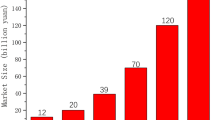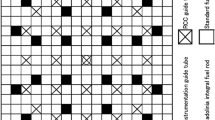Abstract
In recent years, the demand for the radioactive isotope of Cobalt-60 has grown, mostly because of its extensive applications in sterilization of medical equipment and treatment of tumors. Its production for now is mostly carried out in CANDU or RMBK reactors. However, this work analyzed the pressurized water reactor based on the Westinghouse AP1000 design, as PWRs are now considered a possible new Co-60 supplier. Specifically, three different fuel assemblies were investigated, with varying types and number of neutron burnable absorbers used and five fuel enrichments. The Co-59 was inserted as a rod with thin aluminum coating into 4, 6 or 8 guide tubes in the assembly. All calculations were performed using the SERPENT2 Monte Carlo Neutron Transport code with fuel depletion capability. The results have shown that the increased number of cobalt rods indeed led to a greater amount of Co-60 produced, however, did not affect an average per rod but reduced available reactivity. A dependence on the fuel enrichment of the mass of Co-60 produced was observed, while neutron absorbers, on the other hand, did not significantly change the production rate, which implies that the rods could possibly be inserted into various types of assemblies.











Similar content being viewed by others
References
Browne, E.; Tuli, J.: Livechart - table of nuclides - nuclear structure and decay data. https://www-nds.iaea.org/relnsd/vcharthtml/VChartHTML.html, Dec. 2012. Accessed 9 Jan (2023)
Cunningham, J.R.: Cobalt-60 Units for Radiotherapy. Wiley (2006)
Van Dyk, J.; Battista, J.; Almond, P.: A retrospective of cobalt-60 radiation therapy: the atom bomb that saves lives. p. 2020 Oct (2020)
I.A.E.A. (IAEA) Gamma irradiators for radiation processing (2006)
McHaffie, D.; Khuntia, D.; Suh, J.; Tomé, W.; Mehta, M.: Stereotactic Irradiation: Linear Accelerator and Gamma Knife, pp. 331–343. Elsevier Inc. (2012)
Zhang, W.; Niu, F.-L.; Wu, Y.; Guo, Z.-P.: Feasibility analysis of 60co production in pressurized water reactors. Nuclear Sci. Techn. 30, 147 (2019)
Viewpoint: The critical production of cobalt-60 in nuclear reactors. https://world-nuclear-news.org/Articles/The-critical-production-of-cobalt-60-in-nuclear-re (2023)
Ozan, A.: Investigation of the production of cobalt-60 via particle accelerator. Nuclear Technol. Radiat. Protect. 32, 327–333 (2017)
Fabrication, qualification and calibration of 60Co sealed sources, (Rio de Janeiro, Brazil), Associacao Brasileira de Energia Nuclear (2002)
Malkoske, G.; Slack, J.; Norton, J.: Cobalt-60 production in candu power reactors. Can. Nucl. Soc. Bull. 23(3), 16–21 (2002)
Framatome and exelon to explore co-60 production. https://www.world-nuclear-news.org/Articles/Framatome-and-Exelon-to-explore-Co-60-production (2022)
P.R.I.S. (PRIS): https://pris.iaea.org/PRIS/WorldStatistics/OperationalReactorsByType.aspx. Accessed 16 Dec (2022)
Westinghouse ap1000 design control document rev. 19 - tier 2 chapter 1 - introduction and general description of the plant - section 1.2 general plant description. https://www.nrc.gov/docs/ML1117/ML11171A330.pdf (2011)
Leppänen, J.; Pusa, M.; Viitanen, T.; Valtavirta, V.; Kaltiaisenaho, T.: The serpent monte carlo code: status, development and applications in 2013. Ann. Nuclear Energy 82, 142–150 (2015)
Serpent - a continous-energy monte carlo neutron and photon transport code. https://serpent.vtt.fi/serpent/ (2023)
Darnowski, P.; Ignaczak, P.; Obrȩbski, P.; Stȩpień, M.; Niewiński, G.: Simulations of the ap1000-based reactor core with serpent computer code. Arch. Mech. Eng. 65(3), 295–325 (2018)
Westinghouse ap1000 design control document rev. 19 - tier 2 chapter 4 - section 4.1 summary description. https://www.nrc.gov/docs/ML1117/ML11171A443.pdf (2011)
Optimized zirlo\(^{{{\rm TM}}}\) high-performance fuel cladding material. https://info.westinghousenuclear.com/blog/the-art-of- innovation- optimized-zirlo-cladding (2016)
Bragg-Sitton, S.M.: Advanced LWR Nuclear Fuel Cladding System Development Technical Program Plan. Idaho National Laboratory Idaho Falls (2012)
R.S. of Chemistry. https://www.rsc.org/periodic-table/element/27/cobalt
Thurnay, K.: Thermal properties of transition metals (1998)
Judaibi, A.; Soliman, A.Y.: Simulation of cobalt-60 production in research reactors using openmc monte carlo code. Kerntechnik 87(2), 230–236 (2022)
N. C. for Neutron Research. https://www.ncnr.nist.gov/resources/n-lengths/elements/b.html (2001)
Westinghouse ap1000 design control document rev. 19 - tier 2 chapter 4 - reactor - section 4.3 nuclear design. https://www.nrc.gov/docs/ML1117/ML11171A445.pdf (2011)
Acknowledgements
This work is based on the Bachelor’s Thesis ”Study of the production processes of selected medical isotopes in the core of a nuclear reactor” defended by the first Author at Warsaw University of Technology in 2023.
Author information
Authors and Affiliations
Corresponding author
Rights and permissions
Springer Nature or its licensor (e.g. a society or other partner) holds exclusive rights to this article under a publishing agreement with the author(s) or other rightsholder(s); author self-archiving of the accepted manuscript version of this article is solely governed by the terms of such publishing agreement and applicable law.
About this article
Cite this article
Świa̧tkowska, J., Darnowski, P. Analysis of the Cobalt-60 Production in the AP1000-Like Pressurized Water Reactor Using SERPENT2. Arab J Sci Eng (2024). https://doi.org/10.1007/s13369-023-08646-3
Received:
Accepted:
Published:
DOI: https://doi.org/10.1007/s13369-023-08646-3
















